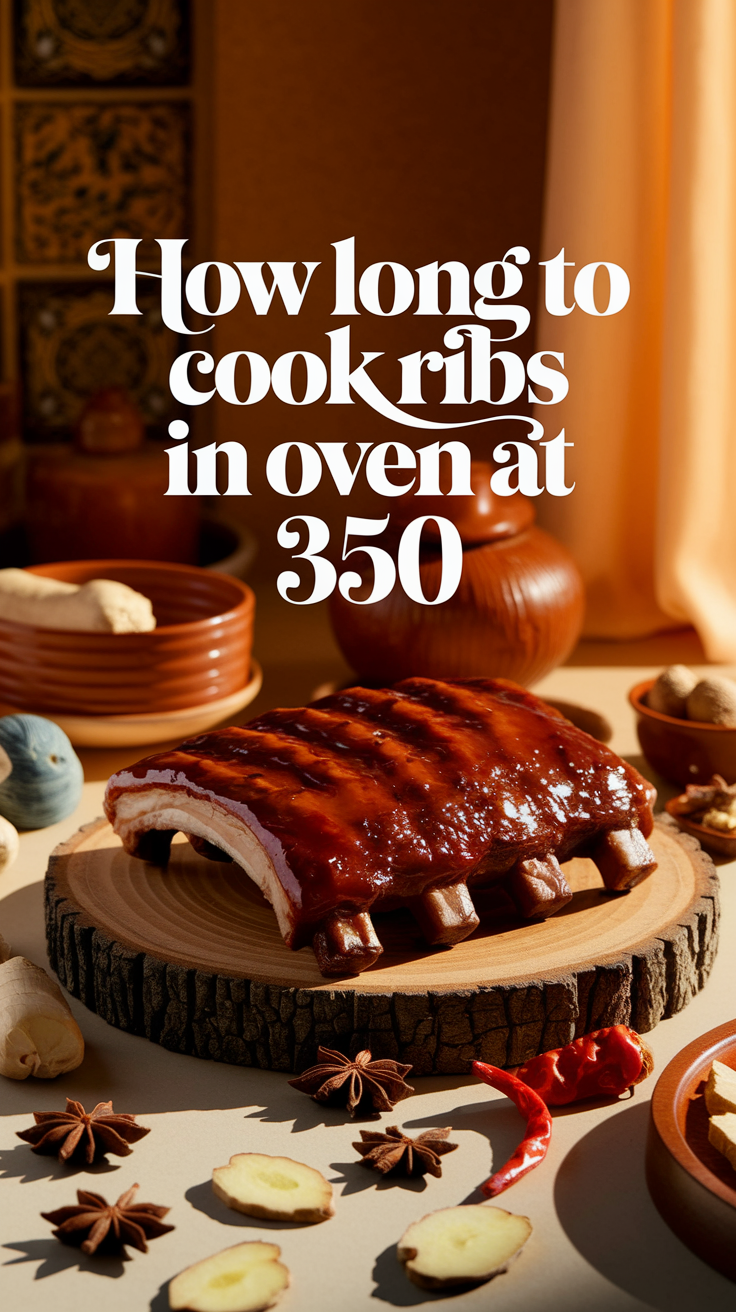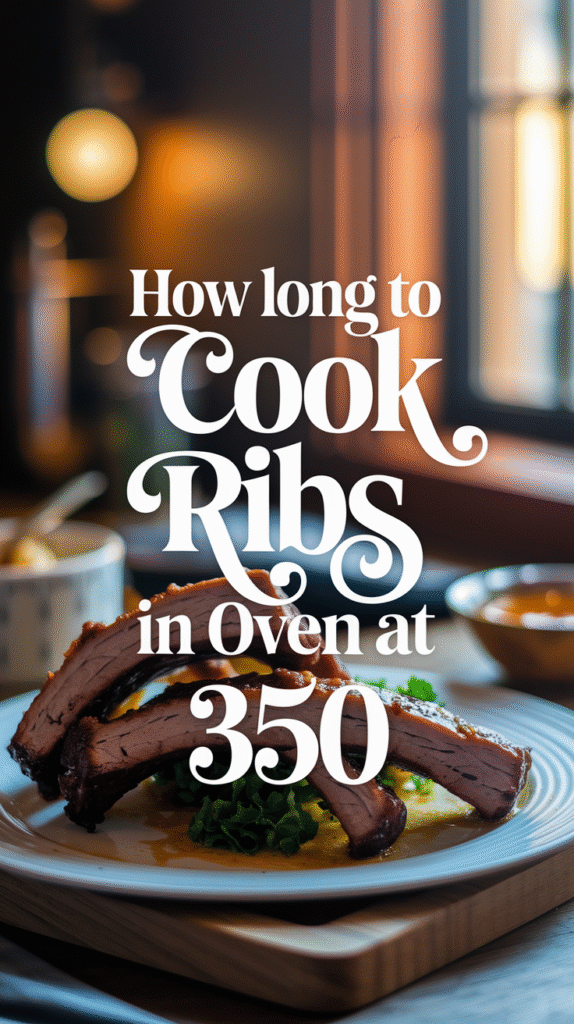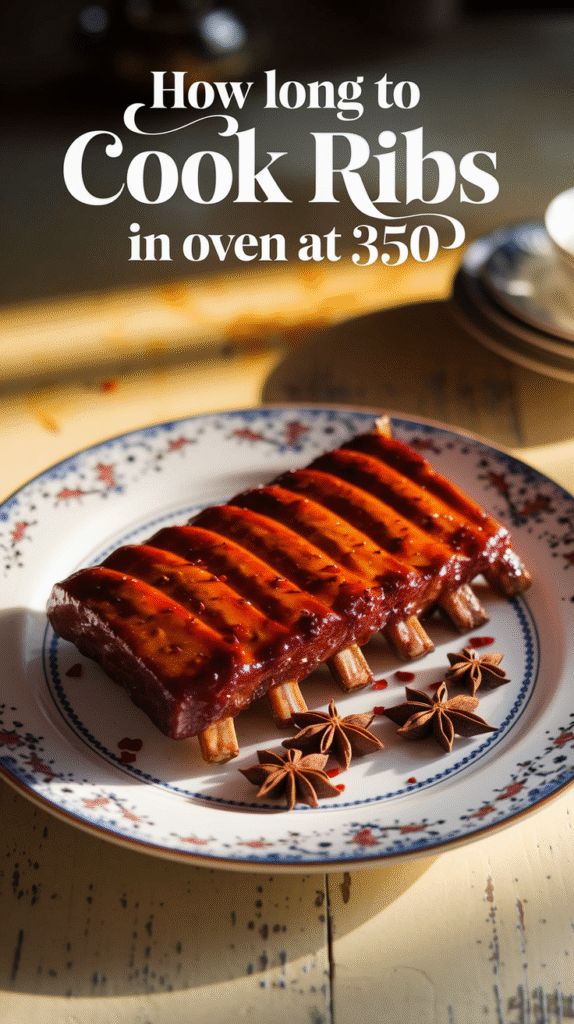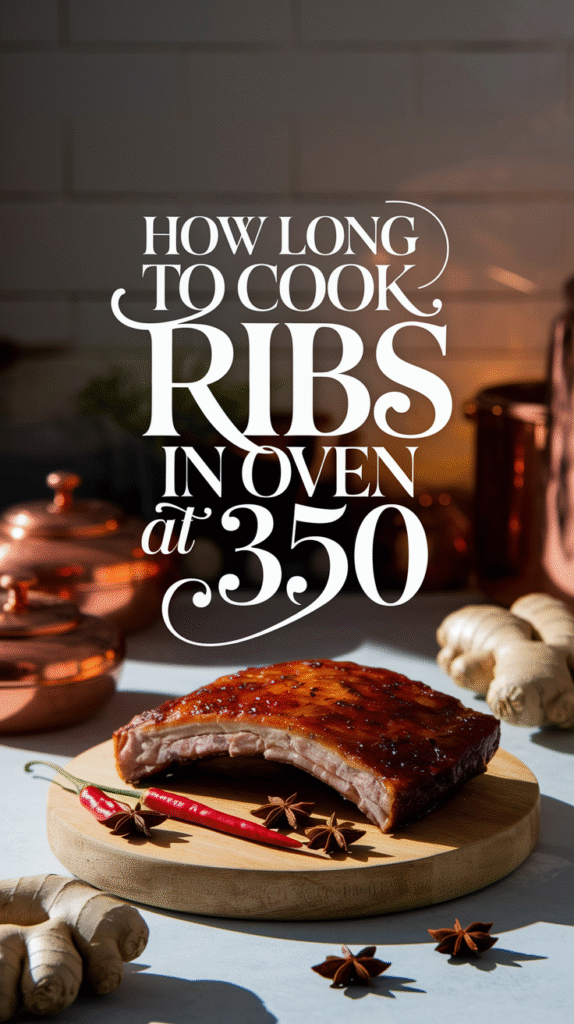Cooking ribs in the oven can yield delightful, tender results that will have everyone coming back for seconds. If you’re wondering how long to cook ribs in the oven at 350 degrees Fahrenheit, you’ve landed in the right spot! This cooking temperature strikes a perfect balance that allows the meat to become tender without drying out.
Understanding Ribs
Before diving into cooking times, let’s clarify the different types of ribs you might consider:
- Baby Back Ribs: These are smaller, more tender ribs from the top of the rib cage. They are typically more expensive but are a favorite due to their tenderness.
- Spare Ribs: These come from the belly area and are larger and meatier. Spare ribs generally take longer to cook.
- St. Louis Style Ribs: These are spare ribs that are trimmed into a rectangular shape and tend to cook similarly to spare ribs.
Optimal Cooking Times
When cooking ribs in the oven at 350 degrees, the cooking time varies based on the type of ribs you’re preparing:
| Type of Ribs | Cooking Time (Hours) |
|---|---|
| Baby Back Ribs | 2.5 to 3 |
| Spare Ribs | 3 to 3.5 |
| St. Louis Style Ribs | 3 to 3.5 |
Preparing Ribs for the Oven
To achieve the best flavor and tenderness, it’s essential to properly prepare your ribs before cooking. Follow these steps:
- Remove the Membrane: Start by peeling off the thin membrane on the back of the ribs. This helps the seasoning penetrate better.
- Season Generously: Use your favorite dry rub or a simple mix of salt, pepper, garlic powder, and paprika. Let the ribs sit for about an hour after seasoning to enhance the flavors.
- Preheat the Oven: Preheat your oven to 350 degrees Fahrenheit. This ensures even cooking throughout the ribs.
Cooking Process
Now that your ribs are prepped, it’s time to cook them. Follow these steps for perfect results:
- Wrap in Foil: Place the seasoned ribs on a large piece of aluminum foil and wrap them tightly. This helps to keep the moisture in.
- Place on a Baking Sheet: Secure the wrapped ribs on a baking sheet. This makes it easier to handle in and out of the oven.
- Bake: Put the ribs in the preheated oven. Depending on the type of ribs, cook for the time indicated in the table earlier.
- Unwrap and Glaze (Optional): For the last 30 minutes, remove the foil and brush your favorite BBQ sauce on the ribs. This adds a beautiful glaze and deeper flavor.
Checking for Doneness
To ensure ribs are perfectly done, look for these signs:
- The meat should pull away from the bones easily.
- A meat thermometer inserted into the thickest part should read at least 145 degrees Fahrenheit, though 190-205 is ideal for tenderness.
Serving Ideas
Once the ribs are cooked to perfection, let them rest for a few minutes before cutting. Pair them with classic sides like:
- Coleslaw
- Mashed Potatoes
- Grilled Corn
- Bread Rolls
For more insights and tips on cooking ribs, check out Food Network’s rib recipes or Serious Eats’ guide on oven ribs.
By following these steps and tips on how long to cook ribs in the oven at 350 degrees, you’ll create a delicious meal that will impress family and friends alike.
The Best Rib Seasonings and Marinades for Oven Cooking
When it comes to crafting mouth-watering ribs in the oven, the right seasonings and marinades can make all the difference. The goal is to enhance the natural flavors of the meat while adding a unique twist that can tantalize your taste buds. Here’s an array of the best rib seasonings and marinades to elevate your oven-cooked ribs.
Popular Dry Rubs
A dry rub is a mixture of spices and herbs that you apply directly to the meat. Here are some classic options:
- Sweet and Spicy Rub: Combine brown sugar, smoked paprika, garlic powder, onion powder, cayenne pepper, and black pepper for a blend that perfectly balances sweetness and heat.
- Herb-Infused Rub: Mix dried oregano, thyme, rosemary, salt, and black pepper. This is an excellent option for those looking to impart an earthy flavor to their ribs.
- Tangy Carolina Rub: Combine white sugar, black pepper, paprika, garlic powder, and a hint of mustard powder for a flavor that packs a southern punch.
Flavorful Marinades
Marinating your ribs can infuse them with deeper flavors. Here are some ideal marinades:
1. Classic BBQ Marinade
Mix together ketchup, apple cider vinegar, Worcestershire sauce, brown sugar, and your favorite BBQ seasoning. Marinate for at least two hours, but overnight is best.
2. Teriyaki Marinade
A sweet and savory alternative, this marinade combines soy sauce, brown sugar, garlic, ginger, and sesame oil. This blend gives your ribs an Asian twist.
3. Citrus and Herb Marinade
This refreshing marinade consists of olive oil, lemon juice, lime juice, minced garlic, fresh herbs like parsley and basil, along with salt and pepper. It’s perfect for tenderizing the meat while adding a zesty flavor.
Using Your Seasonings and Marinades Effectively
To maximize flavor, it’s essential to apply your seasonings and marinades correctly. Here are some tips:
- Prep Your Ribs: Remove the membrane from the back of the ribs. This helps the seasonings penetrate better.
- Time it Right: For dry rubs, allow at least 30 minutes of resting time before cooking. For marinades, aim for a minimum of 2 hours, preferably overnight for maximum flavor.
- Pace Your Flavor: If you’re using a strong marinade, consider reducing the marinating time to prevent overpowering the meat’s natural flavor.
Cooking Tips for Oven-Baked Ribs
After seasoning your ribs, cooking them properly is the next step. Here’s how to achieve the perfect oven-cooked ribs:
- Preheat the Oven: Always preheat your oven to 350°F (175°C) for evenly cooked ribs.
- Wrap it Up: To maintain moisture, wrap the seasoned ribs in aluminum foil before placing them in the oven. This will create a steamy environment that keeps the meat tender.
- Glaze for Greatness: If you love BBQ sauce, apply it during the last 30 minutes of cooking. This will caramelize the sauce on the ribs for a mouth-watering finish.
Where to Find More Inspiration
Looking for more rib seasoning ideas and recipes? Check out these resources:
By using the right seasonings and marinades, your oven-cooked ribs can go from ordinary to extraordinary. Enjoy experimenting with these flavors, and soon, you’ll be serving up tender and flavorful ribs that everyone will love.
Comparing Oven Cooking to Grill Cooking for Ribs
When it comes to cooking ribs, both oven and grill methods have their unique advantages and flavors. Understanding how each method works can help you decide the best way to prepare this delicious dish. Here’s a closer look at how oven cooking compares to grill cooking for ribs.
Flavor Differences
The flavor you achieve when cooking ribs can differ significantly between the oven and the grill. When grilling, you get that coveted smoky flavor due to the direct exposure to wood or charcoal. This infuses the meat with rich layers of flavor that many BBQ enthusiasts love. On the other hand, oven cooking traps moisture and allows for a tender, juicy finish in the ribs, although the smoky flavor can be less pronounced. You can enhance the taste in the oven by using smoked paprika or liquid smoke in your marinade.
Cooking Time
Cooking times can vary greatly depending on the method you choose. Generally, when cooking ribs in the oven at 350°F, you’ll want to allow:
- Baby Back Ribs: Approximately 2.5 to 3 hours.
- Spare Ribs: Roughly 3 to 4 hours.
In contrast, grilling can take about 1.5 to 2.5 hours, depending on the heat and thickness of the ribs. It’s essential to monitor the cooking to ensure the ribs don’t dry out on the grill.
Juiciness and Tenderness
One of the key advantages of cooking ribs in the oven is the ability to control the temperature and cooking environment. The oven allows ribs to cook slowly and maintain moisture, resulting in tender meat that falls off the bone. Use a covered roasting pan or wrap the ribs in foil to create a steamy environment. Grilling, while offering a wonderful char, can sometimes lead to drier ribs. You can combat this by using a marinade or basting sauce frequently, but it requires more attention during cooking.
Crispiness of the Bark
The texture of the finished ribs can vary based on the cooking method. Grilling typically produces a crispy bark that many people associate with great barbecue. This crust forms due to the direct heat and caramelization of sugars in the sauce. You can achieve a similar effect in the oven by broiling the ribs for a few minutes at the end of the cooking time. This adds a final crispy touch without sacrificing tenderness.
Convenience and Cleanup
From a convenience standpoint, cooking ribs in the oven can be easier for many home cooks. You can set the oven to the desired temperature, place the ribs in, and let them cook without constant flipping or basting. Additionally, cleanup is typically simpler with oven-cooked ribs as you can cook them in a roasting pan lined with foil. Grilling, however, may require more attention throughout the cooking process and often leads to more utensils and tools needing cleaning.
Health Considerations
When considering health factors, oven-cooked ribs can be seen as a slightly healthier option. Cooking in the oven can reduce flare-ups that occur during grilling, which can cause harmful compounds to form. You can also control the amount of sauce or seasoning, making it easier to create a healthier dish. Grill cooking can allow for more fat rendering, giving it a richer flavor but potentially higher calorie content if not managed.
Final Notes
Ultimately, the choice between oven cooking and grilling ribs will depend on your preferences and circumstances. If you desire that deep smoky flavor and the traditional barbecue experience, grilling may be the way to go. However, if you want tender, juicy ribs with less supervision and easier cleanup, opt for the oven. Both methods can produce mouth-watering results that are sure to impress your family and friends.
Serious Eats and Smoking Meat offer excellent guides and tips for mastering your rib-cooking techniques. Combining the best of both worlds might also be the answer; you can start cooking the ribs in the oven and finish them on the grill for that perfect blend of tenderness and flavor.
Tips for Ensuring Tender and Flavorful Ribs
Cooking ribs to perfection is an art that many aspire to master. To ensure your ribs are tender and packed with flavor, the following tips will guide you through the process.
Choosing the Right Ribs
The first step in ensuring mouth-watering ribs starts with selecting the right type of ribs. There are various cuts, each offering a unique taste and texture:
- Baby Back Ribs: These ribs are smaller and leaner, taking roughly 2 to 3 hours to cook.
- Spare Ribs: Larger and meatier, spare ribs require about 3 to 4 hours and offer more flavor due to their fat content.
- St. Louis Style Ribs: A trimmed version of spare ribs, these can take about 2.5 to 3.5 hours to become tender.
Preparation Techniques
Now that you’ve chosen your ribs, it’s crucial to prepare them properly:
- Remove the Membrane: There’s a thin membrane on the back of the ribs that can be tough. Removing it will allow flavors to penetrate better.
- Dry Rubs: Use a mix of spices as a dry rub to enhance the flavor. Ingredients like paprika, garlic powder, and brown sugar work wonders in creating a delicious crust.
- Marinating: Letting your ribs marinate for several hours or overnight can further enhance their flavor. Consider using ingredients like apple cider vinegar, soy sauce, or even beer for a rich taste.
Cooking Methods
When it comes to cooking ribs in the oven, the right method can make all the difference:
- Slow and Low: Cooking ribs at a lower temperature for a longer time results in more tender meat. If you’re cooking at 350°F, plan on 2.5 to 3.5 hours.
- Wrap in Foil: Consider wrapping your ribs in aluminum foil after the first hour of cooking. This retains moisture and helps them cook more evenly.
- Use a Baking Sheet: Place a rack over a baking sheet to catch drippings. This helps create a better cooking environment.
Applying Sauce
If you love saucy ribs, timing is crucial:
- Last 30 Minutes: Apply your favorite barbecue sauce during the last 30 minutes of cooking to avoid burning and to allow the sauce to caramelize over the ribs.
- Multiple Layers: For extra flavor, consider applying multiple layers of sauce, allowing each layer to set in before adding more.
Resting Before Serving
Once your ribs are done cooking, don’t just dive in:
- Let Them Rest: Allow the ribs to rest for at least 10 to 15 minutes before slicing. This helps to seal in juices, making them even more flavorful.
- Cover with Foil: While resting, cover them with foil to keep them warm without continuing to cook.
What to Serve with Ribs
Round out your meal with complementary sides:
- Coleslaw: A crunchy slaw can balance the meatiness of the ribs.
- Potato Salad: Creamy potato salad is a classic side that pairs well with barbecue.
- Cornbread: Sweet cornbread is a delicious accompaniment that enhances the overall meal experience.
For further insights and ideas on cooking ribs to perfection, visit Genius Kitchen and Serious Eats.
Remember, perfect ribs come from practice and experimentation. Use these tips to create a rib dish that’s not just good, but unforgettable!
Common Mistakes to Avoid When Cooking Ribs in the Oven
Cooking ribs in the oven can be a delicious way to enjoy this classic dish, but there are several common mistakes that can ruin your meal. Understanding these pitfalls can help you achieve tender, flavorful ribs that will impress your family and friends. Here are several mistakes to watch out for:
Not Preparing the Ribs Properly
One of the first steps to successfully cooking ribs is proper preparation. Many people skip removing the membrane on the back of the ribs. This thin, tough skin can make the ribs chewy and less flavorful. To remove it, simply slide a knife under the membrane at one end and pull it off using a paper towel for better grip.
Cooking at the Wrong Temperature
Another common error happens when people don’t pay attention to the cooking temperature. While 350°F is a popular choice for oven cooking ribs, you have to consider the size and type of ribs you’re using. Baby back ribs require less cooking time than spare ribs. If you cook them at the right temperature but for the wrong amount of time, you may end up with dry meat. Aim for about 2 to 2.5 hours at this temperature for tender ribs.
Overseasoning or Underseasoning
Finding the right balance of seasoning is crucial. Be sure to use spices, marinades, or dry rubs based on your personal taste. If you’re worried about over seasoning, start small and build up. Remember to also season the ribs well before cooking, as this allows for deeper flavor penetration.
Failing to Use Foil
Wrapping ribs in foil can retain moisture and enhance tenderness. If you skip this step, you risk ending up with dry and tough ribs. By wrapping the ribs tightly in foil, you create a steamy environment that will keep your ribs juicy. Consider cooking them like this for the first half of the cooking time.
Not Allowing Enough Rest Time
Patience is critical when cooking ribs. Many people cut into the meat immediately after taking it out of the oven, which causes precious juices to escape. After removing the ribs, let them rest for at least 10 to 15 minutes. This allows the juices to redistribute, resulting in moist and flavorful meat.
Skipping the Sauce or Glaze
While some may prefer dry ribs, brushing your cooked ribs with barbecue sauce or glaze can add extra flavor. However, apply the sauce during the last 30 minutes of cooking to avoid burning the sugars. If you add it too early, you risk charring the sauce and losing its tasty flavor profile.
Not Giving Ribs Time to Caramelize
Caramelization brings out the natural sugars in the meat and gives a delightful crust. If you want that beautiful caramelized finish, don’t hesitate to put your ribs under the broiler for the last few minutes of cooking. Just keep a close eye on them to avoid burning.
Ignoring Internal Temperature
The perfect ribs are cooked to the right internal temperature. For pork ribs, aim for an internal temperature of 190-205°F. This ensures the collagen breaks down, making the ribs tender. Use a meat thermometer to verify this temperature, as it is the most reliable way to assess doneness.
Not Cleaning Up
Cleaning as you go not only makes the cooking process smoother but also ensures a safer kitchen. Raw meat can carry bacteria, and proper hygiene can prevent cross-contamination. Always wash your hands and surfaces that the raw meat has come into contact with to avoid any foodborne illness.
Cooking ribs in the oven can be simple and rewarding when you avoid these common mistakes. For further reading about rib cooking techniques, check out Food Network’s ribs section or visit Serious Eats for expert guides.
| Mistake | Impact |
|---|---|
| Not removing membrane | Tough ribs |
| Incorrect cooking temperature | Dry meat |
| Over/Under seasoning | Flat flavor |
| Skipping foil | Dry texture |
| Not allowing rest time | Juiceless meat |
| Ignoring internal temperature | Tough and inedible |
Keeping these tips in mind while cooking your ribs can help elevate the quality of your dish. Happy cooking!
Conclusion
Cooking ribs in the oven at 350 degrees can be a rewarding experience that brings delicious flavors to your table. With the right timing and temperature, you can achieve perfectly tender ribs that will impress your family and friends. A proper balance of seasonings and marinades not only enhances the natural taste of the meat but also helps to keep it moist during the cooking process.
When comparing oven cooking to grill cooking, it’s clear that each method has its benefits. While grilling provides a smoky flavor, oven cooking ensures that the ribs cook evenly and are less susceptible to unpredictable weather conditions. With the oven, you control the environment, making it easier to achieve consistent results.
To ensure your ribs are both tender and bursting with flavor, remember to cover them while cooking and allow them to rest afterward. This simple step can make a significant difference in texture and taste. It’s equally important to be aware of common pitfalls, such as cooking ribs at too high a temperature or skimping on seasoning. By avoiding these mistakes, you’ll set yourself up for success.
Ultimately, whether you’re a seasoned cook or just getting started, mastering the art of oven-baked ribs at 350 degrees is a skill worth developing. With the right techniques and a little practice, you’ll be able to serve up meal after meal of irresistible, mouth-watering ribs that will keep everyone coming back for more. Happy cooking!







Leave a Reply